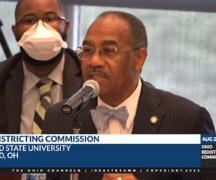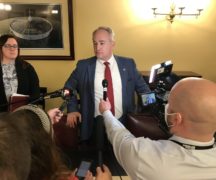BY NICK EVANS
The Ohio redistricting commission met in Deer Creek State Park Friday to discuss the latest version of General Assembly district lines.
The proposal, introduced by Sen. Rob McColley, R-Napoleon, would maintain durable supermajorities for the GOP in both chambers. The party’s advantage, according to GOP mapmakers themselves, would likely give them control of 62% of House seats and 70% of Senate seats.
That’s a far greater advantage than the 54-46 split in favor of Republicans that was meant to guide the previous redistricting process. Republican members contend the 10-year frame of reference has shifted, and that the change increases their advantage.
Democratic members argue back that the GOP proposal overshoots even that increase.
Public input
The state constitution requires at least three regional hearings around the state to gather public input. Friday’s turnout, though, was meager. The number of people in the audience was roughly equivalent to the number of commissioners and staffers sitting on the dais.
Fair districts advocates and Democratic members warned that might happen when the commission set the public hearing schedule. House minority leader and Democratic commissioner Allison Russo reiterated that point, criticizing the lack of access.
“While I love our Ohio State Parks, scheduling these at a state park that has no public transit that I’m aware of that comes directly to the park, in the middle of a workday, presents many challenges for many different members of communities who are deeply impacted by these maps,” Russo said.
Common Cause executive director Catherine Turcer urged the panel to start over. She insisted there’s a strong argument the newest proposal makes “zero improvement” on the current unconstitutional map.
“The manipulation of district lines is the manipulation of elections,” Turcer argued. “The manipulation of elections is the manipulation of public policy.”
“So at the end of the day,” she continued, “manipulating districts to favor one political party over the other manipulates all sorts of important decisions that are made at the statehouse.”

Auditor Keith Faber defended Republican efforts. In effect, he argued constitutional requirements paint mapmakers into a corner.
“We have this inherent conflict that I think you’ve identified between competitiveness, and this concept of, I call it the magical mystery ratio, you call it proportionality,” Faber argued.
Faber insisted the competing interests of not favoring a party and reflecting statewide partisan preferences simply aren’t compatible.
Splitting the uprights
To at least some extent, Geoff Wise agreed with Faber. Wise has spoken at previous meetings and submitted draft proposals of his own.
He explained there’s an unavoidable tension in the constitution between neutrality and partisan performance. Wise argued Republicans seize on the idea of not favoring a party when they push back on changes that improve Democratic performance. Meanwhile Democrats emphasize the requirement that maps reflect the state’s overall partisan preference.
Wise explained Ohio’s political geography is such that a neutral map would make it easier for the GOP to overperform. As an example, he shared a map drawn without partisan data. In a hypothetical 55-45 election, Republicans would pick up 65 House seats.
“There’s no magic wand where if I don’t look at partisan data, I magically come up with proportionality,” he said. “That’s just not what happens with a state like Ohio because it’s unbalanced, and because it’s Republican. That’s just the reality.”
But Wise stressed that’s not a blank check for partisan mapmakers. Instead, he compared those competing constitutional demands to football goalposts.
“Every single kick is going wide right,” he argued. “And I don’t really care whether it’s on purpose, or accidental. It’s unconstitutional — even using the Republican viewpoint of partisan fairness.”
Borrowing an argument made in court filings by Senate President Matt Huffman, Wise argued the commission needs to start from a neutral map and then work toward a more proportional performance. Because of the state’s partisan distribution Wise says drafters will need to look for tweaks in large and mid-size counties. Using a Huffman map introduced in 2021, Wise identified Hamilton, Lorain, Lucas, Wood, Montgomery and Summit counties as good areas to adjust proportionality.
More hearings?
The commission’s Monday hearing conflicts with Yom Kippur. Co-chairs Faber and Senate Minority Leader Nickie Antonio said they were working to schedule additional hearings.
After one of Friday’s speakers criticized the lack of meetings outside of business hours, Russo tried to get the commission to consider an evening hearing as well. Sen. McColley objected, arguing the panel can consider such a hearing without a formal vote.
After Faber and Antonio informally agreed to attempt to coordinate additional hearings Russo pulled her motion.
The next hearing is 10 a.m. today, Monday, Sept. 25 at Punderson Manor and Lodge in Newbury Township.
Also from Ohio Capital Journal:
Anti-democratic moves by state lawmakers raise fears for 2024 election
In Wisconsin, Republican lawmakers are threatening to impeach both the state’s election administrator, who is highly regarded nationally, and a state Supreme Court justice despite a ruling by the state’s judicial commission that the justice had done nothing wrong — effectively nullifying a recent statewide election she won, Democrats say.
In North Carolina, a bill that would give the legislature control of state and local election boards — potentially allowing lawmakers to overturn results — could soon become law.
Alabama continues to defy the U.S. Supreme Court by refusing to draw a new congressional district with a Black majority.
And after forcing voters to cast ballots in unconstitutionally gerrymandered districts in 2022, Ohio Republicans have recently proposed new maps that retain their gerrymandered supermajority control over the legislature, after enacting one of the most restrictive voter laws in the country earlier this year, and spending the summer campaigning to roll back the constitutional power of Ohio voters.
Other states are seeing efforts by politicians to gain a political advantage by curtailing the power of voters. READ MORE






